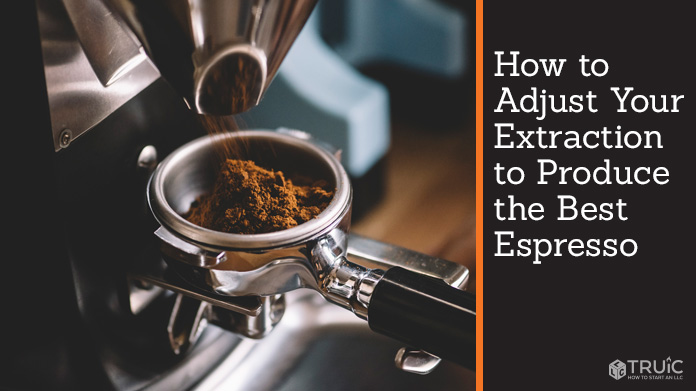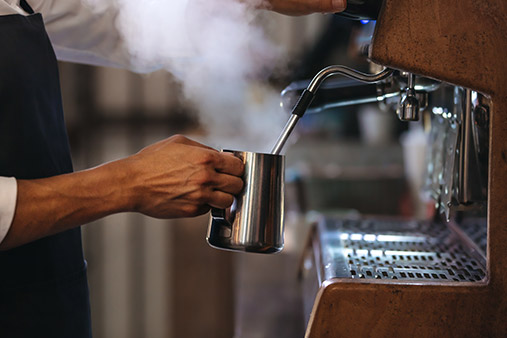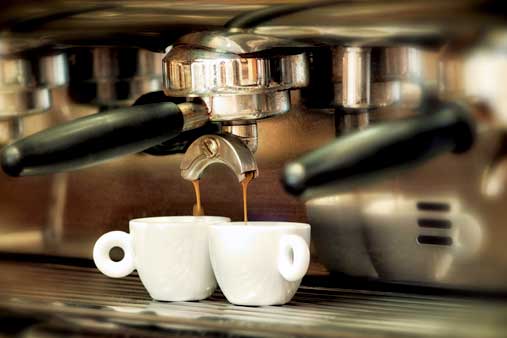How to Adjust Your Extraction to Produce the Best Espresso
Extracting espresso focuses on pulling out the flavors within a coffee that you want to showcase while minimizing those you don’t. More importantly, it’s about learning how to dial in espresso until it delivers your desired tasting notes. Written by coffee professionals, this guide provides the tools you’ll need to extract a well-crafted shot of espresso.
Recommended: Read our full, in-depth How to Start a Coffee Shop Business guides, inspired by coffee professionals, they will help make your coffee dreams real, from sourcing beans to hiring baristas, choosing a POS system, forming an actual company, and everything in between.

What Should Espresso Taste Like?
An ideally extracted espresso will taste sweet and ripe with a full body, complex acidity, and a lingering finish. Only by evenly extracting a coffee’s acids, fats, and sugars can you produce a balanced and tasty shot. The exact flavor notes will vary based on the coffee used, but even the highest-quality coffee can taste lackluster when extracted incorrectly.
Espresso Extraction Basics
Extracting espresso is a balancing act in which you try to highlight the flavors that occur between overextraction and under extraction.
So what exactly happens when you extract espresso?
Water acts as a solvent to pull flavor from the coffee beans by first dissolving acids and fats. Acids create sour flavors in coffee while fats and oils contribute to its body. The water then dissolves sugars within the beans that add sweetness to a coffee’s flavor. Finally, the plant fibers of the coffee bean dissolve and add bitterness. The goal is to hit the sweet spot in which you pull just the right amount of flavor from the beans to produce a sweet-tasting espresso with a syrupy body.
Before you can extract a perfect shot of espresso, however, you must understand the difference between the two extractions you want to avoid. These include:
- Overextraction: This happens when you pull out too many flavors, causing your coffee to taste bitter and astringent with an overall flavor profile that falls flat on the palette. Overextracted espresso also has a dry mouthfeel similar to the sensation of drinking unsweetened, black iced tea. So what can cause this?
- Your Grind May Be Too Coarse. This will cause water to flow more quickly through the coffee than desired for a good extraction.
- Your Extraction Time May Be Too Long. When water runs through coffee for longer than it should, it extracts more of the plant fibers responsible for creating bitterness.
- You’re Not Using Enough Coffee. If your dose is too low, it creates an imbalance in the ratio of water to coffee.
- Your Water’s Too Hot. This will burn your coffee and make it taste bitter.
- Under Extraction: This happens when you fail to pull out enough flavor, causing your coffee to taste sour without the sweetness you want in an espresso. The flavors you do pull out also will leave your palette quickly rather than lingering like a well-crafted shot. Sometimes, people confuse under extraction with the acidity they look for in espresso. However, under extraction promotes a lip-puckering sensation rather than bringing out brightness. So what can cause this?
- Your Grind May Be Too Fine. This causes water to move slowly through the coffee and extract unevenly.
- Your Extraction Time May Be Too Short (Or You Pulled the Shot Too Quickly). Either way, this will prevent you from extracting the coffee’s fats and sugars thereby leaving you with a sour-tasting shot.
- You’re Using Too Much Coffee. If your dose is too high, it creates an imbalance in the ratio of water to coffee.
- Your Water’s Too Cold. This will prevent your coffee from extracting fully.
How Does an Espresso Shot Extract Unevenly?
If you don’t evenly disperse the coffee in your portafilter, it will produce an uneven extraction. A few ways this can happen include:
- You Used an Uneven Tamp. This leaves room for excess water to pool on one side of the grounds, extracting one half more than the other.
- You Have Uneven Water Distribution. If you think about pour over methods, you’ll produce an awful cup of coffee if you leave half of the grounds dry after pouring water on the other half. The same goes for espresso. Even water distribution is important to the full extraction of coffee.
- You Have Broken or Agitated Grounds. Even if you tamp your espresso well, you can disrupt the grounds within the portafilter if you hit it on something or tap its side with your tamper before tamping. Broken or agitated grounds can trap water in the cracks of the coffee, which will extract those areas more than others.
Action Plan for Adjusting Your Espresso Extraction
You have many options when adjusting the extraction of your espresso. That can feel a bit overwhelming — especially during busy hours of the day when you have little time to spare to dial in an uncooperative shot.
To help streamline this process, here’s where you should start making adjustments:
- Adjust the Grind. When pulling an espresso shot, grind your coffee very finely. Do this in small movements (e.g., grind and discard a few ounces of coffee) and then purge the throat of your grinder between every adjustment. This approach will give your grinder the time it needs to adjust while it clears out any previously ground coffee
- Adjust the Extraction Time. Say you pull an espresso shot for 22 seconds and it comes out under extracted. Increasing your extraction time to 23 or 24 seconds could completely change the taste of your espresso. The same goes for shortening the extraction time
- Adjust the Dose. The amount of coffee you use directly impacts the time it takes for water to travel through the grounds and extract the coffee. If your dose is too high, you’ll under extract the coffee and end up with a sour shot. Whether you want to correct an under extracted or overextracted shot, adjusting the dose in small increments can completely change the flavor profile of your espresso.
If none of these small adjustments improve the extraction of your espresso, it’s time to look elsewhere. Here’s what to try next:
- Adjust the Water Temperature. The optimal water temperature for extracting a well-crafted shot of espresso ranges from 195 to 205 degrees Fahrenheit. If your water temperature exceeds this, your espresso will over extract and taste burnt. If your water is too cold, it will under extract your espresso. Check the temperature gauge on your espresso machine to see if your water temperature falls outside of this optimal range.
Water at the wrong temperature likely stems from one of three reasons: your boilers didn’t heat up because you haven’t used your machine recently (this typically happens in the morning), there’s something wrong with your boilers, or someone accidentally changed your machine’s water temperature. Most higher-end espresso machines will allow you to calibrate your own temperature. Because each machine operates a bit differently, refer to its manual for guidance on how to adjust the water temperature with ease. - Adjust the Water Pressure. Water pressure is extremely important to espresso extraction, and espresso machines operate best with nine bars of pressure. That equates to the weight of air at sea level, 130 pounds per square inch (PSI) more than the pressure in car or bicycle tires, or 10 percent of the pressure exerted by a typical pressure washer.
Adjusting the water pressure in your espresso machine will either make your shot extract faster or slower so you need to know which way to make an adjustment. Anything too low or too high will make it difficult to pull a good shot. When adjusting your espresso machine’s water pressure, stop when it reaches nine bars of pressure. - Check Your Coffee’s Roast Date. Have you experienced a slower-than-usual period in the last few weeks? If so, your coffee may sit around for longer than normal. Older coffee can start to extract differently than when it’s fresh, causing it to lose its sweetness and well-rounded flavor. The same is true for coffee roasted within the last five days. Coffee that’s too fresh will continue to off-gas, hindering your ability to pull a shot that tastes as flavorful and rich as you’d like. Typically, these shots will fall flat on the tongue.
Conclusion
Many factors contribute to proper espresso extraction. From the grind of your coffee to your espresso machine’s water temperature, every detail counts. Understanding how to adjust these factors will make it easier to produce the best espresso possible.
If you need help branding your coffee business, try using our Free Coffee Shop Logo Maker. Our free tool will help you brand your coffee business with a unique logo to make your small business stand out.


